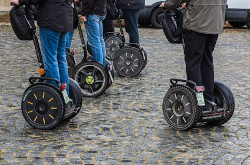전기 스쿠터

Electric scooters are everywhere in cities across the United States. They are one of the most popular forms of shared transportation. And they often anger people who must share the roads and sidewalks with them.
The scooters have become even more popular than station-based bicycles, bicycles that must be left at specific locations.
A new report by the National Association of City Transportation Officials notes that in 2018, Americans took around 38.5 million trips on shared electric scooters. In comparison, riders only took 36.5 million trips on shared, station-based bicycles.
More Americans, with the help of their smart phones, are exploring alternatives to car ownership. They are using other devices, such as shared scooters and bikes, to get around. This is known as the micromobility revolution, leading many companies to compete for the business.
Bird is a California scooter company that began in late 2017. It has raised $418 million and had more than 10 million rides in its first year.
Lime, which offers both shared bikes and scooters, had more than 12 million rides and $467 million in investment in its first 15 months.
Even automobile companies are getting involved in the micromobility business.
The car-sharing service Uber bought Jump Bikes, an electric bike and scooter company. Last year, it invested $30 million in Lime.
Ford, a car manufacturer, bought scooter company Spin in November.
Sunny Madra is vice president of Ford’s mobility businesses. In an interview with the Associated Press, he noted that working on micromobility services could have benefits for the company in the future.
“… this is a great way for us to make sure that we’re part of the transformation of mobility," he said.
If it seems like electric scooters appeared overnight in America, that is because they did. Several companies distributed them throughout cities without permission or permits.
However, U.S. cities are now requiring scooter companies to share their location data. This data shows where the scooters are and which routes they take. That information can be valuable to plan bike routes and docking stations or to understand traffic patterns. But the data also raises questions about user privacy.
Regina Clewlow is the head of Populus, a company that works with cities on data and privacy issues.
She notes that some people are concerned about privacy because “if you take enough GPS data points and begin attaching other data sets, it [the information] can be used to identify specific individuals."
Another concern of growing electric scooter use is head injuries.
Dr. Vishal Bansal is with the Scripps Mercy Hospital in San Diego, California. He noticed many riders were getting on scooters after a night of drinking alcohol, without wearing a helmet.
Christopher Ziebell of Dell Seton Medical Center in Austin, Texas said that people who go fast on scooters without helmets are in particular danger.
“If your head hits concrete at 20 miles (32 kilometers) an hour, you are not going to get up," he said.
Ziebell noted that the scooters "have little tiny wheels on them, so it doesn’t take much for a rider to go flying off.”
Some industry watchers wonder how long the demand for electric scooters will last. Automobile industry analyst Maryann Keller says she thinks some of the scooter companies are not as valuable as they are reported to be.
“These little fads come and go,” Keller said. For those wishing for the scooter fad to go, they might have to wait a little longer.

